Use 'Print preview' to check the number of pages and printer settings.
Print functionality varies between browsers.
Printable page generated Thursday, 25 April 2024, 2:50 AM
Study Session 15 Looking to the Future
Introduction
We started this Module with the broader global context for WASH and the challenges that led to the creation of the One WASH National Programme. As you reach the end of the Module, you have learned about the ambitious goals of the OWNP and the plans for achieving them. In this final study session we broaden the scope again and look to the future to consider some of the changing issues in Ethiopia and the wider world that may affect OWNP plans and implementation. Planning for the future can never be entirely certain but it’s possible to manage the uncertainty by recognising that change will happen and being prepared to adapt to its influence.
The design of the OWNP in two phases was intended to allow for review and adjustment in response to change at the end of Phase 1, with Phase 2 following for the next five years. In the OWNP document the possible redirection of the Programme is acknowledged. It suggests that in future there could be ‘different policy priorities, targets, institutional roles and responsibilities and/or implementation modalities’. Broadening the Programme in future may consider such topics as ‘watershed and water resources management, productive uses of water, environmental protection, and climate resilience’ (OWNP, 2013).
In this study session we will first consider the dynamics of the OWNP itself and the developments in national policy. Then we will look to wider issues of urbanisation, industrialisation and climate change that may affect implementation of the OWNP. Finally, the study session returns to the Millennium Development Goals that set the international agenda until 2015 and considers what happens next.
Learning Outcomes for Study Session 15
When you have studied this session, you should be able to:
15.1 Define and use correctly all of the key words printed in bold. (SAQs 15.1, 15.4 and 15.5)
15.2 Outline how the Growth and Transformation Plan II and other developments may affect OWNP implementation. (SAQ 15.2)
15.3 Explain the possible effects of increasing population, urbanisation and industrialisation on water supply. (SAQs 15.1 and 15.3)
15.4 Describe the possible influence of climate change on the OWNP. (SAQ 15.5)
15.5 Outline the possible impact of the Sustainable Development Goals. (SAQ 15.6)
15.1 The OWNP and its dynamics
The world is a dynamic place and for any long-term programme like the OWNP the possibility of change needs to be taken into account. Some future changes may be expected and predictable, others may be unforeseen. Some will have positive effects, others may be negative. Being aware of and understanding possible change is important so that impacts can be mitigated. Mitigation means reducing the negative effects of some undesirable event or situation.
In previous study sessions you have learned about the policies that underpin the OWNP, the institutional arrangements and organisation at different levels of government, and the approach to financial management. As the Programme develops it is possible that these central structures and its organisation may change over time, especially if monitoring reveals there are better ways of doing things that could improve efficiency. The review at the end of Phase 1 and the ongoing M&E process that you read about in Study Session 13 will provide feedback on the Programme that may require changes to timescale and implementation plans.
In Study Session 14 you read that the total amount of money required for the OWNP is estimated to be US$2.41 billion. The contributions to the Consolidated WASH Account and funds from other donors have provided a large part of this fund, but the full amount is not yet secured. Furthermore, like any financial estimate, there is always some degree of uncertainty about possible variations in budget forecasts due to unforeseen circumstances. One possible example of the unforeseen is an uncontrollable natural disaster or crisis that requires reallocation of funds in response to a shift in national priorities. There is no guarantee that all the necessary funds for WASH improvements will be committed to the Programme.
The dynamics of the OWNP are also a function of its ‘newness’ in Ethiopia. The ‘One Plan, One Budget, One Report’ principle of the OWNP has led to innovative collaborations and partnerships that are still relatively new. The challenges of integration and harmonisation among stakeholders and of developing new ways of working require changes in long-standing practices, and this can take time before new relationships are fully developed. These cultural and behavioural changes all contribute to the challenge of achieving the OWNP goals.
15.2 Growth and Transformation Plan II
As you read previously in this Module, the targets of the OWNP were developed from the Growth and Transformation Plan (GTP) and Universal Access Plan (UAP), with the National Hygiene and Sanitation Strategic Action Plan. The first GTP covered the period from 2010 to 2015 and a revised version, GTP II, was launched in 2015 and will cover 2016 to 2020. The overall objective of GTP II will be further development of the national economy and to contribute to the plan for Ethiopian to be a middle-income country by 2025. GTP II recognises the challenges for WASH over the next few years. Several of these, including climate change and industrialisation, are discussed in further detail in the following sections. Other challenges have been identified including:
- problems of good governance, especially of urban water supply schemes where leakage management is an issue
- weak integration and coordination between stakeholders in the urban development programme, especially within key ministries
- high costs and delays in delivering imported spare parts and installation materials.
In terms of impacts and change affecting WASH, the main strategic directions for GTP II reinforce many of the principles of the OWNP such as good governance, building capacity, empowerment of women, support for private sector development, support for pastoralist regions, community mobilisation and strengthening of M&E (MoWIE, 2015). For water supply and sanitation infrastructure, GTP II aims to upgrade the water supply service to the level of middle-income countries by 2020 and establish urban wastewater management systems. But probably the most significant changes are new water supply service level standards.
The new criteria for access are set at a higher level than they were in the OWNP. The goal for rural water supply is now a minimum service level of 25 litres per person per day (previously 15 litres) within a distance of 1 km (previously 1.5 km). For urban supply, the new criteria vary with the size of the town. Table 15.1 shows the classification of towns based on population size and the required amount of safe water to be supplied to a single person per day.
| Town level | Population | Service level (litre/person/day) |
|---|---|---|
| 1 | >1,000,000 | 100 |
| 2 | 100,000–1,000,000 | 80 |
| 3 | 50,000–100,000 | 60 |
| 4 | 20,000–50,000 | 50 |
| 5 | 40 |
(Note that for towns in levels 1 to 4, the water should be available at the premises; for level 5, the minimum service level is within a distance of 250 m.)
Changing the criteria for water access could have a significant impact on the OWNP. As you know from Study Session 14, these criteria are used as the basis for planning the number and location of new water schemes, so these new criteria will affect both physical and financial plans.
15.3 Increasing population
One significant trend putting pressure on water and sanitation provision in many parts of the world is population growth. As you can see in Figure 15.1, Ethiopia shows a steepening curve as the population grows each year. This puts ever-growing demands on limited resources, including water.

How would you summarise the availability of water resources in Ethiopia?
From Study Session 2, you may remember that Ethiopia as a whole has plentiful water resources, but these are not distributed evenly throughout the country either geographically or seasonally.
In areas where there are limited resources and demand is high, water use can lead to depletion of groundwater resources. Groundwater depletion means that the stores of water held underground within the rocks are gradually reduced because too much water has been extracted via wells and boreholes. This leads to a lowering of the water table so that wells have to be dug or drilled deeper and deeper before water is found.
As well as the added direct demand for water to meet basic needs, an increasing population can also lead to growing competition for water for other purposes such as agriculture and industry. Greater use of irrigation in order to grow more food to feed a larger number of people can mean that less is available for water supply. In the longer term, the OWNP, and any WASH programmes that follow it, will have to adjust to the continuing increase in demand from the growing population.
15.4 Urbanisation
In Ethiopia, not only is the total population growing fast, but it is also on the move. Many people are moving away from rural areas and into the towns and cities, resulting in an increase in the urban population. The urban population is the percentage of the total population resident in urban areas. In Ethiopia in 2015 this is about 18%. Urbanisation is the increase in the number of people living in towns and cities, relative to rural areas. Figure 15.2, which you first saw in Study Session 6, shows the trend in urbanisation from 1950 onwards. Note that this includes predicted figures to the year 2050. The gradient (steepness) of the red line is slightly greater beyond 2015, indicating that urbanisation is predicted to increase at a faster rate.
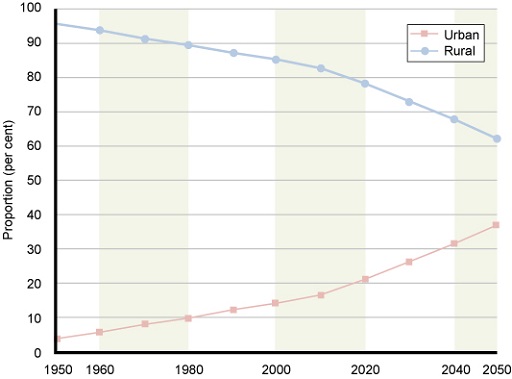
The movement of people from rural to urban settings is becoming a major issue. These people arrive in need of somewhere to live, and although there are many signs of economic growth and development in urban areas, it is a challenge for towns in Ethiopia to absorb migrants from rural parts of the country and provide them with adequate housing. The current stock of urban housing is both insufficient and of poor quality. Only 27% of the urban population has access to improved sanitation, with another 42% using shared facilities, leaving 31% with unimproved or no latrine access (data for 2012, JMP, 2014a). The serious deficiencies in sanitation services and random defecation in urban areas have created dangerous health and environmental problems.
New construction to meet the demands of urbanisation may not solve these problems. In Addis Ababa and other cities in Ethiopia many condominiums and other housing are being built to provide accommodation for the growing urban population (Figure 15.3). Rapid construction without adequate planning procedures can mean that buildings are erected without having the necessary infrastructure in place, i.e. water supply and sanitation may not be part of the construction or may be inadequate or delayed. Poorly designed buildings can be short-term solutions to meet the pressing need for more housing but they will not be sustainable. These are the growing challenges that the OWNP in its future implementation will need to take into account.
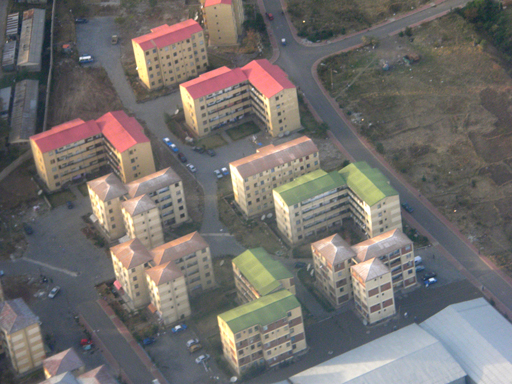
15.5 Industrialisation
Industrialisation is the process of change from an agriculture-based economy, with most people working on the land, to one based on industry with people employed in manufacturing, construction and other sectors. It is linked to urbanisation because many of the people moving to urban areas do so in search of work and most factories and other forms of industry are located in towns and cities. Industry in Ethiopia has an important role in contributing to the economy of the country by alleviating poverty, and providing opportunities for employment for jobless citizens. However, it can also create problems and potentially have negative effects on water resources and the environment.
Many industries are growing fast in Ethiopia and can exert added demand for water supply. Industry may also cause pollution of water resources. Pollution can be defined as the presence or release into the environment of any substance that can cause harm. If industrial expansion is not controlled, and if appropriate regulations are not in place and enforced, then the environment may suffer. Water sources may become polluted and unsafe for human consumption. In Addis Ababa, the Akaki River has become severely contaminated by industrial wastewater that has been discharged untreated into the river with damaging impacts on local people, domestic animals and wildlife, both in the immediate location and downstream of the source of pollution (Figure 15.4).
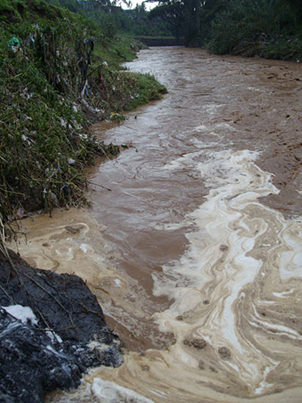
15.6 Climate change
The effects of climate change are already being experienced in Ethiopia (EPA, n.d.). Climate change is the long-term variation in global climate largely attributed to human activities, especially the production of greenhouse gases (e.g. carbon dioxide, methane). These are gases that, when released to the atmosphere, trap the heat from the sun and cause warming of the global climate. Figure 15.5 shows how this process operates.

In recent decades, Ethiopia has become warmer and rainfall has become more variable. Table 15.2 shows this historical trend and how the climate models have predicted the possible future changes. As you can see, as well as changes to temperature and rainfall, there are also expectations of increased uncertainty about extreme events of flood and drought. The weather in Ethiopia is likely to become more unpredictable and this will impact on many sectors, including health, agriculture and natural resources, including water.
| Temperature | Rainfall | Extreme events | |
|---|---|---|---|
| Historical trend | Mean temperature increased by 1.3°C from 1960 to 2006. More hot days and nights, fewer cold days and nights | Highly variable from year to year, season to season, decade to decade. No significant trend | Regular, severe floods and drought events. No evidence of changes in frequency or intensity of extremes |
| 2020s | +1.2°C (range 0.7–2.3°C) | +0.4% increase in rainfall | Greater increases in rainfall from October to December, especially in the south and east |
| 2050s | +2.2°C (range 1.4–2.9°C) | +1.1% increase in rainfall | Heavier rainfall events, uncertain future El Niño behaviour brings large uncertainties |
| 2090s | +3.3°C (range 1.5–5.1°C) | Wetter conditions | Flood and drought events likely to increase, heatwaves and higher evaporation |
The future uncertainties of climate change are acknowledged in the OWNP document and it recognises that water supplies are vulnerable to climate variability. Some existing water sources may dry out during prolonged dry periods, but it is also possible that increased rainfall will improve supply. Future plans need to incorporate how they will adapt to these possible changes. Adaptation to climate change means modifying actions and behaviours to cope with the changed situation, for example, using scarce water resources more efficiently would be one way of adapting to reduced water supplies. The greatest problem with climate change is the level of uncertainty about the future which makes it very difficult to prepare strategic plans for the longer term.
In response to these challenges, the Ethiopian government has mandated the Environmental Protection Authority (EPA) to coordinate the national response to climate change and to develop national plans for a climate-resilient economy. Climate resilience is the ability to cope with and manage a changing and uncertain climate. A climate-resilient economy is an economy designed to withstand the possible negative impacts of extreme weather events and long-term climate trends, so that the well-being of the people and the national economy are not damaged (EPA, n.d.).
In 2014, Ethiopia’s Programme of Adaptation to Climate Change (EPACC) was launched. This is a programme of action to build a climate-resilient economy involving all levels, from sectoral and regional to local communities. It aims to involve the whole population in planning and implementing adaptation to climate change and includes the objective to ‘manage water effectively to make it always available to humans, animals and crops’ (EPA, n.d.).
Ethiopia is not responsible for the historic atmospheric greenhouse gas emissions, but nevertheless it has developed plans for actions to mitigate climate change. These are called the Nationally Appropriate Mitigation Actions (NAMAs). They cover seven areas of activity, all designed to decrease the production of greenhouse gases in Ethiopia. One of the most important is electricity generation by renewable energy such as hydropower, wind power and geothermal power, both at national grid and local level and on a domestic scale. Figure 15.6 shows an example of a renewable energy scheme.
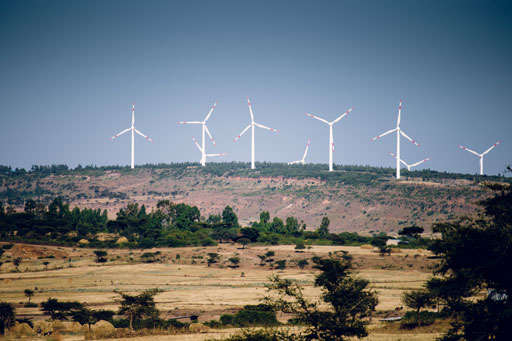
What is the difference between adaptation to climate change and mitigation of climate change?
If you adapt to something you make changes that allow you to cope with the change, so adaptation to climate change means changing programmes, activities, behaviours etc. in response to a changing situation. Mitigation means reducing the negative effects of something, so in this instance it would mean trying to prevent further climate change from happening.
15.7 International development goals
The year 2015 sees the end of both Ethiopia’s GTP I and the planned first phase of the OWNP. It was also the target date set by the United Nations in 2000 for achieving the Millennium Development Goals (MDGs).
15.7.1 Millennium Development Goals
You will recall from Study Session 2 that there were eight MDGs, and that Goal 7 included the aim to halve, by the end of 2015, the proportion of people without sustainable access to safe drinking water and basic sanitation. The goal for basic sanitation has not yet been achieved but, after a concerted effort by the Ethiopian government, the public and development partners, in March 2015, Ethiopia celebrated meeting the target for water supply. This made Ethiopia one of the few countries in sub-Saharan Africa to fulfil this global commitment. Figure 15.7 shows a UNICEF poster designed for the event and the celebration by assembled stakeholders held at the Sheraton Hotel, Addis Ababa on 23 March 2015.
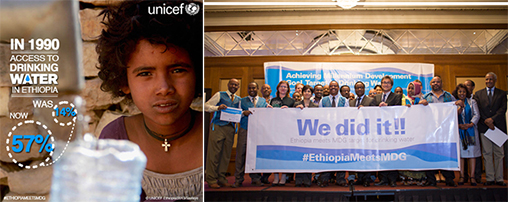
This was a great achievement for Ethiopia but, despite huge improvements across all eight goals across the globe, there are still many targets that have not been met. The global community has therefore developed a new set of goals called the ‘Sustainable Development Goals’.
15.7.2 Sustainable Development Goals
The Sustainable Development Goals (SDGs) were finalised at a world summit in September 2015. There are 17 goals, rather than the previous eight, allowing more specific details to be included. Box 15.1 has details of the goal that relates to WASH.
Box 15.1 Water and the Sustainable Development Goals
Goal 6, which applies to WASH, is: ‘Ensure access to water and sanitation for all’. It has the following specific targets:
- By 2030, achieve universal and equitable access to safe and affordable drinking water for all.
- By 2030, achieve access to adequate and equitable sanitation and hygiene for all, and end open defecation, paying special attention to the needs of women and girls and those in vulnerable situations.
- By 2030, improve water quality by reducing pollution, eliminating dumping and minimizing release of hazardous chemicals and materials, halving the proportion of untreated waste water, and increasing recycling and safe reuse globally.
- By 2030, substantially increase water-use efficiency across all sectors and ensure sustainable withdrawals and supply of freshwater to address water scarcity, and substantially reduce the number of people suffering from water scarcity.
- By 2030 implement integrated water resources management at all levels, including through trans-boundary co-operation as appropriate.
- By 2020 protect and restore water-related ecosystems, including mountains, forests, wetlands, rivers, aquifers and lakes.
- By 2030, expand international co-operation and capacity-building support to developing countries in water and sanitation related activities and programmes, including water harvesting, desalination, water efficiency, wastewater treatment, recycling and reuse technologies.
- Support and strengthen the participation of local communities in improving water and sanitation management.
(UNDP, 2015)
You can see that these new goals introduce aspects of water management that were not included in the MDGs. Water quality, for example, has been added in recognition of the problems caused by pollution and the impact this can have on the availability of usable water. Inclusion of water quality targets brings another dimension that could affect the OWNP implementation.
What other impacts will these new goals have on the WASH programme in Ethiopia? In short, we don’t know. The previous MDG was framed in terms of halving proportions, but the new SDG is less compromising and requires availability for all by 2030. The current OWNP Phase 2 is scheduled to end in 2020, and already has the target of 100% access to water and sanitation by that time. If it succeeds that will precede the SDG target by ten years! There are great challenges ahead in achieving this target, but the harmonisation, integration, alignment and partnership principles of the OWNP will all be profoundly important in achieving this goal.
15.8 Conclusion
The One WASH National Programme is a new development for Ethiopia. Having studied this Module you will know there are several reasons why the OWNP is exceptional. It is:
- united: it brings together four ministries who have agreed to implement one programme
- inclusive: all aspects of WASH are included
- comprehensive: it will be rolled out nationwide in all regions of Ethiopia
- innovative: it is the first sector-wide approach in the Ethiopian WASH sector
- effective: funds are pooled into one account
- progress-oriented: it will lead towards achieving national results faster
- supportive: all relevant stakeholders in the sector work together.
To conclude this study session and this Module, we would like briefly to refer back to the fourth component of the OWNP and the requirement for capacity building in WASH. We hope that, having studied this Module, you are now fully aware of the significance of Ethiopia’s One WASH National Programme, including its aims, principles, approaches, structure and management. We hope that your capacity has also been developed and you feel able to contribute to achieving the goals of the OWNP.
Summary of Study Session 15
In Study Session 15, you have learned that:
- Dividing the OWNP into two phases recognises the need for review and adjustment to allow for change. It is therefore probable that the policies, principles, institutional and financial arrangements of the OWNP will change in future.
- GTP I ended in 2015, to be replaced by GTP II. GTP II reinforces the improvements in many themes of GTP I, including good governance, involvement of women, better integration and coordination among stakeholders.
- GTP II includes new access criteria for water supply that will affect OWNP targets, and therefore physical and financial plans.
- An increasing population means an increasing demand for water for household use and also for agriculture and industry.
- The urban population is increasing, with additional demand for efficient, reliable and sustainable water and sanitation provision.
- Climate change has an uncertain impact on water supply into the future, but planning should take account of adaptation and mitigation measures. The Environmental Protection Authority has responsibility for the national response to climate change and is promoting steps to achieve a climate-resilient economy.
- The Millennium Development Goals target date was 2015. Ethiopia achieved the target for access to water in March 2015. New goals called Sustainable Development Goals have been agreed for the period to 2030.
Self-Assessment Questions (SAQs) for Study Session 15
Now that you have completed this study session, you can assess how well you have achieved its Learning Outcomes by answering these questions.
SAQ 15.1 (tests Learning Outcomes 15.1 and 15.3)
Fill in the gaps in the following sentences:
- Urbanisation is the increase in the ………………, relative to rural areas.
- ……………… means reducing the negative effects of some undesirable event or situation.
- Urban population is the ……………… of the total population resident in ……………… areas.
- ……………… is the long-term variation in the global climate, largely attributed to human activities, especially the production of ……………… gases.
- The presence or release into the environment of any substance that can cause harm is known as ………………
Answer
- Urbanisation is the increase in the number of people living in towns and cities relative to rural areas.
- Mitigation means reducing the negative effects of some undesirable event or situation.
- Urban population is the percentage of the total population resident in urban areas.
- Climate change is the long-term variation in global climate largely attributed to human activities, especially the production of greenhouse gases.
- The presence or release into the environment of any substance that can cause harm is known as pollution.
SAQ 15.2 (tests Learning Outcome 15.2)
Identify the main ways in which GTP II will affect WASH and the OWNP.
Answer
The water supply service level standards in GTP II are higher than they were when the OWNP was planned. This means that more water per person is required closer to their homes in order to meet the requirements for minimum service level. GTP II also aims to improve water supply infrastructure to the level of middle-income countries and establish new urban wastewater management systems.
SAQ 15.3 (tests Learning Outcome 15.3)
In the context of WASH, explain why simply building more houses is not a sustainable solution for urbanisation.
Answer
Rapid construction without adequate planning procedures can mean that buildings are erected without having the necessary infrastructure in place, i.e. water supply and sanitation may not be part of the construction or may be inadequate or delayed. Poorly designed buildings can be short-term solutions to meet the pressing need for more housing but these will not be sustainable.
SAQ 15.4 (tests Learning Outcomes 15.1 and 15.3)
The leather industry is one of the key industries in Ethiopia, and traditionally the main leather-related export has been hides and skins. The government has been driving the leather industry to focus instead on producing high-value finished leather products, for example shoes and handbags, encouraging the evolution from a traditional industry to a modern industry that functions within a global high-value market.
- a.In terms of social and national change, this is an example of what?
- b.Identify one possible advantage of this development, and one possible disadvantage.
Answer
- a.Industrialisation.
- b.Advantages could include alleviating poverty, providing improved physical infrastructure and generating opportunities for employment. Disadvantages could include increased pollution for both the environment and the water supply.
SAQ 15.5 (tests Learning Outcomes 15.1 and 15.4)
- a.Why is it difficult to plan for climate change?
- b.The EPA is developing national plans for a climate-resilient economy. What does this mean?
Answer
- a.The greatest problem about climate change is the level of uncertainty about the future, which makes it very difficult to prepare strategic plans for the longer term.
- b.A climate-resilient economy is an economy designed to withstand the possible negative impacts of extreme weather events and long-term climate trends so that the well-being of the people and the national economy are not damaged.
SAQ 15.6 (tests Learning Outcome 15.5)
Which of the following statements is false? In each case explain why it is incorrect.
- A.Water quality was not an indicator in the WASH-related MDG.
- B.Ethiopia has met its aim to halve, by the end of 2015, the proportion of people without sustainable access to safe drinking water and basic sanitation.
- C.The targets within the new WASH-related SDGs specify women and girls as needing particular support in achieving access to adequate and equitable sanitation and hygiene for all.
- D.The OWNP is more ambitious than the SDGs, aiming to reach a target of 100% access to water and sanitation ten years sooner than the SDGs.
- E.The target date for the SDGs is 2035.
Answer
B is false. Ethiopia has reached the goal for water supply but not for sanitation.
E is false. The target year is 2030.